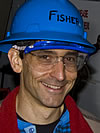 Andrew T. Fisher |
2016 O.E. Meinzer Award
Presented to Andrew T. Fisher
Citation by Steve Ingebritsen
It is a distinct pleasure to present Andy Fisher’s O.E. Meinzer Award citation.
In the twentieth century, only the plate tectonic revolution had a greater impact on our understanding of Earth processes than the discovery of subsea hydrothermal systems, which helped to spawn the exciting field of “subsea hydrogeology.” Andy Fisher is a leading practitioner in this field, a prolific and influential scholar, and a most worthy recipient of the 2016 Meinzer Award.
Subsea hydrogeology is often counterintuitive compared to onshore hydrogeology. For instance, whereas flow in the continental crust is mainly from topographic highs towards topographic lows, subsea circulation is mainly from lows toward highs, driven by density differences caused by geothermal heating. The first of five papers cited in support of Andy’s Meinzer Award explains this phenomenon (JGR 1990).
Further, whereas sedimentary rocks are commonly more permeable than the underlying crystalline rocks on land, the oceanic crust tends to be much more permeable than the overlying sediments. Thus subsea flow tends to be concentrated in the “basement” below the sediments. The second paper cited is a broad overview of the permeability structure of the oceanic crust (RoG 1998), and the third and fourth papers (Nature 2000; Nature 2003) document the role of basement outcrops in guiding and focusing fluid flow across long distances.
Andy Fisher moved to the University of California at Santa Cruz following the untimely death of Shirley Driess. As Shirley’s successor, Andy broadened his sphere of investigation to include onshore processes. And indeed the final paper cited (WRR 2006) is an application of heat as a tracer in studies of surface water-groundwater interactions. Andy and his colleagues are applying this and other tools in more recent studies of groundwater recharge, demonstrating that his research interests continue to expand.
The papers cited in support of the 2016 Meinzer Award are as follows:
- Fisher, A.T., Becker, K., Narasimhan, T.N., Langseth, M.G., and Mottl, M.J., 1990, Passive, off-axis convection through the southern flank of the Costa Rica Rift: Journal of Geophysical Research, v. 95, p. 9343–9370.
- Fisher, A.T., 1998, Permeability within basaltic oceanic crust: Reviews of Geophysics, v. 36, p. 143–182.
- Fisher, A., and Becker, K., 2000, Reconciling heat flow and permeability data with a model of channelized flow in oceanic crust: Nature, v. 403, p. 71–74.
- Fisher, A.T., et al., 2003, Hydrothermal recharge and discharge across 50 km guided by seamounts on a young ridge flank: Nature, v. 421, p. 618–621.
- Hatch, C.E., Fisher, A.T., Revenaugh, J.S., Constantz, J., and Ruehl, C., 2006: Quantifying surface water-ground water interactions using time series analysis of streambed thermal records: method development: Water Resources Research, v. 42, doi:10.1029/2005WR004787.
 2016 O.E. Meinzer Award — Response by Andrew T. Fisher
2016 O.E. Meinzer Award — Response by Andrew T. Fisher
Thank you, Steve, for your generous citation, and for your support and encouragement over the years. My academic and scientific career has been defined by a series of fortuitous events and opportunities. I was an elementary school student when plate tectonic theory became widely known—what an exciting time to be interested in geological topics. I don’t remember exactly when I first heard about groundwater, but after multiple viewings of “Journey to the Center of the Earth” and every episode of “Jonny Quest,” I recall envisioning vast, subterranean caves filled with frothing cataracts of tumbling water…and the fins of gigantic sharks cutting through the rapids.
I started college intending to major in math, but a freshman course in marine geology with Jim Ingle reset my path. As a college senior, I learned about groundwater modeling in a computational earth science class with John Harbaugh. Seafloor hydrothermal vents had recently been discovered, and I decided to enroll in the graduate oceanography program at the University of Miami, naively thinking that I might be able to get on a ship. I was Keir Becker’s first graduate student, and six months after arriving in Miami, found myself on the deck of the DR/V JOIDES Resolution, bound for the north Atlantic Ocean. Ocean drilling was a fantastic platform for learning about multidisciplinary, international research. Through Keir, ocean drilling, and the National Science Foundation RIDGE program, I was introduced to additional collaborators and role models such as Marcus Langseth, Miriam Kastner, Joris Gieskes, Dick Von Herzen, Earl Davis, Heiner Villinger, Nari Narasimhan, Susan Humphris, Clive Lister, Joe Cann, and Leslie Smith (a partial listing, but space is limited!)—looking back now, I can't believe my good fortune in having so many opportunities for discussion, exploration and discovery with these and other scientific pioneers.
Also as a graduate student, I sailed on the ODP drillship to the Barbados accretionary complex with Casey Moore from University of California at Santa Cruz, never imagining that one day, I would be his departmental colleague. Casey, Eli Silver, Bob Garrison, and many others welcomed me to UCSC two decades ago, and the years have passed quickly. As my research program has diversified into terrestrial hydrogeology, and particularly surface water-groundwater interactions and managed recharge, there has been additional encouragement from luminaries such as Ken Bencala, Graham Fogg, and Roger Bales. UCSC is a great place to be an advisor, and I’m grateful for the many talented, energetic and creative students and postdocs with whom I’ve had the privilege to work. Finally, I have to thank my wife and daughter, who have tolerated so many long absences, including those when I'm sitting across from them at the dinner table but my mind is elsewhere. To all of you, the Hydrogeology Division of GSA, and many additional collaborators and colleagues, I offer sincere appreciation for your generosity, support, and friendship. Thank you for this honor.
